Snakes are vicious eaters and have a diverse diet, including frogs, birds, eggs, fish, and many more! But, they also have voracious predators that kill them at will.
What animals eat snakes? Some of the animals that eat snakes are:
- Bobcat—This animal is fierce when it comes to hunting snakes. It sinks its claws into the snake’s head and bites, making it hard for snakes to fight back.
- Honey Badger—This is another ferocious animal that kills snakes at will. They kill snakes by dashing, biting, lunging, and lifting them nonstop, giving little to no time for snakes to retaliate.
By reading this guide, you will know the rest of the animals that eat snakes, their characteristics, identification, and their respective habitats. So, if you want to know more, consider reading on!
Table of Contents
Can Snakes Eat Other Snakes?
Snakes are opportunistic creatures and eat their own species. They particularly do this, especially in cases when prey is scarce.
Can Humans Eat Snakes?
Many people eat snakes, particularly rattlesnakes since their diet mainly involves insects, smaller reptiles, and rodents. However, one should ensure a thorough cooking process to avoid infection.
11 Snake Predators Identification
Snakes have several fierce predators that await them wherever they go, and these are:
Bobcats
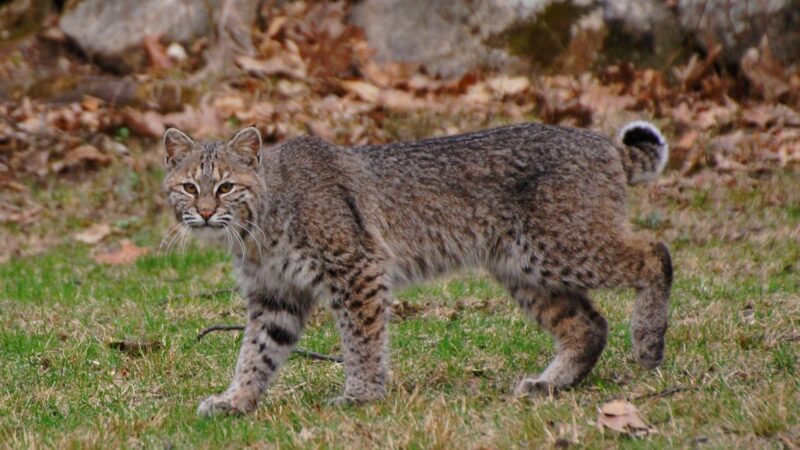
Bobcats have a diverse diet, including lizards, rabbits, rodents, eggs, and snakes. These snake predators are solitary and highly territorial.
They mark their boundaries using their scents to let other cats know that the territory is already taken. They are elusive and silently stalk snakes before lunging them to the ground with brute force.
Moreover, use their sharp hearing, fast moves, turns, and agile attacks. Bobcats have an entire set of teeth that includes molars, premolars, and canines—which are sharp enough to grab their snake prey and strip them into pieces.
- Appearance: Bobcats, also occasionally called wildcats, are almost twice the size of an average housecat. They have large paws, tufted ears, and long legs, comparable to their larger relative—the Canada lynx. They usually have a brownish-red or brown underbelly with hints of white and a short tail with a black tip.
- Size: 48 cm to 120 cm in length (adult), 6.4 kg to 18 kg for males, and 4 kg to 15 kg for females
- Color: Reddish to grayish brown
- Lifespan: 7 years
- Habitat: Bobcats are versatile creatures and can live in diverse habitats, including bottomland hardwood forests and coastal marshes in the southeast, mixed forests and boreal coniferous in the north, and scrublands and desert in the southwest.
- Characteristics: Bobcats have big paws, lengthy legs, and tufted ears. They’re known for their shy nature, but they can get aggressive when you attempt to touch them.
Crocodiles

Crocodiles share the same trait as snakes—they are both opportunistic predators. They eat whatever they can find, and snakes aren’t an exception.
These hefty predators hook down their prey using their huge jaws, whip it and swallow it whole. Since crocodiles cannot chew their food in tiny pieces, they ingest small stones to act as food grinders on their stomach.
- Appearance: Crocodiles own strong jaws with multiple conical teeth and short shanks with clawed webbed toes. They have unique body structures that allow their ears, eyes, and nostrils to show on the water surface. In addition, their tail is massive and long, and their skin is plated and thick.
- Size: 17 feet in length and 1,000 pounds on average weight
- Color: Brown or light olive green
- Lifespan: 70 years
- Habitat: Estuaries and mangrove swamps
- Characteristics: Crocodiles are opportunistic eaters. They possess sharp pressure receptors found in their scales’ pits close to the mouth, which detect motion and help catch their prey.
Fox
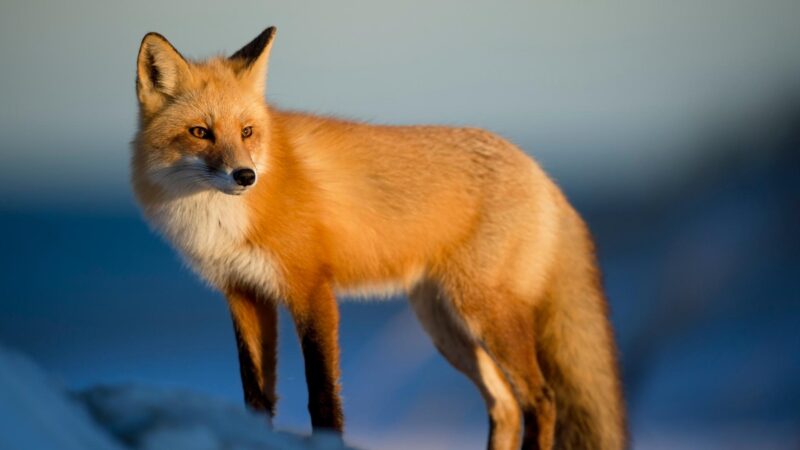
Foxes being omnivores, have a diverse diet. This implies that they feast on both vegetation and meat, including rats, rabbits, mice, lizards, and snakes.
They especially love to devour snakes, whether vigorously chasing them or eating carcasses they come across.
- Appearance: Foxes have brown to reddish-brown fur with a white chest and a bushy tail with a white tip. In addition, their ears and nose are pointed, and their feet are black.
- Size: 45 cm to 90 cm in length (adult) and 2.2 kg to 14 kg in weight (adult)
- Color: Red, light yellow, frosted black, and auburn red
- Lifespan: 3 to 4 years
- Habitat: Forested areas, grasslands, mountains, deserts
- Characteristics: Foxes are solitary creatures with long fur, relatively short legs, pointed ears, and a narrow nose. They also make different sounds for various reasons, like warning their competing partners, attracting mates, or for self-defense.
Related: 13 Facts About Foxes You May Not Know | Information and Facts
Honey Badger
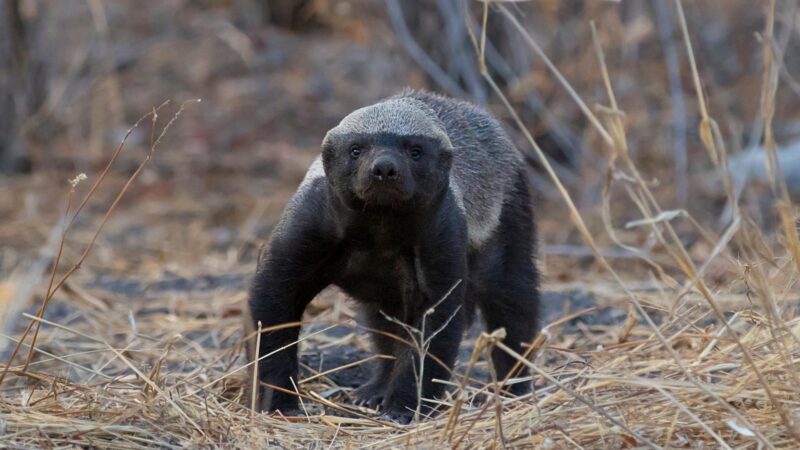
Honey badgers, also called ratels, are related to otters, skunks, and ferrets. They’re omnivores and got their name from their love for honeybee larvae and honey.
Amphibians, insects, birds, mammals, snakes, as well as roots, fruits, and bulbs, are also part of their diverse diet. These snake predators are notorious for their ferocity, strength, and toughness when encountering their prey.
For instance, they’re known to fearlessly attack and savagely attack almost any animal species when given the chance. The porcupine quills, animal bites, and bee stings rarely penetrate their skin.
They eat snakes like a normal meal and don’t get affected even when bitten by a venomous snake since they have an unusually terrific immunity to snake venom.
- Appearance: Honey badgers have plump, flat bodies with short, muscular legs. They also have long claws, which they use for defense and digging. They have thick, black hair with white to gray stripes stretching across their back, coming from the top of their head to the tip of their tail.
- Size: 55 cm to 77 cm in length (adult), 9 kg to 16 kg in weight for male adults, and 5 kg to 10 kg for female adults
- Color: Black, brown, or grey
- Lifespan: 24 years
- Habitat: Mountains and rainforests
- Characteristics: Badgers have thick skin and are fearless in attacking their snake prey. These carnivores have stout bodies with powerful jaws, anal scent glands, and large, plump claws on their forefeet.
Laughing Falcon
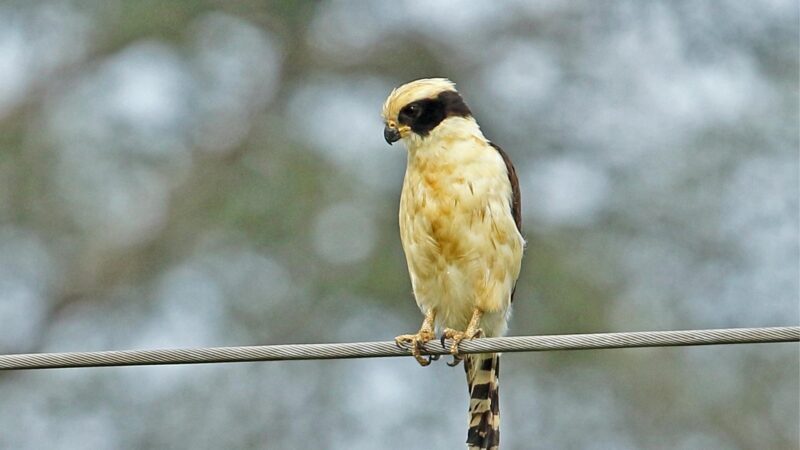
Laughing falcons, also known as snake hawks (since they’re snake-eaters), are solitary birds but not during mating season. They are generally crepuscular—which means they are usually active when it’s dusk and dawn.
They have a dark and white color with a long barred tail and rounded wings. The male adults’ upper parts are dark brown, with a wide cinnamon patch at the flight feathers’ base.
Their primary diet is snakes, and they hunt for them ferociously. They pounce on their venomous prey from the air and bite opponents’ heads using their sharp beaks.
Nonetheless, their food choice isn’t limited to snakes. They also prey on small mammals, lizards, fish, grasshoppers, and birds.
- Appearance: The laughing falcons have rounded, short wings and long tails with at least four white bands. The male adults possess dark brown upper parts and dark brown wings with a wide cinnamon mark that can be seen during their flight.
- Size: 44 cm in length (adult), 400 g to 800 g in weight (adult)
- Color: Dark and white
- Lifespan: Close to 14 years
- Habitat: Grasslands, arctic tundras, forests, and deserts
- Characteristics: Falcons are well-known for their formidable strength and speed, lethal nature, sharp eyesight, and excellent hunting skills.
Mongoose
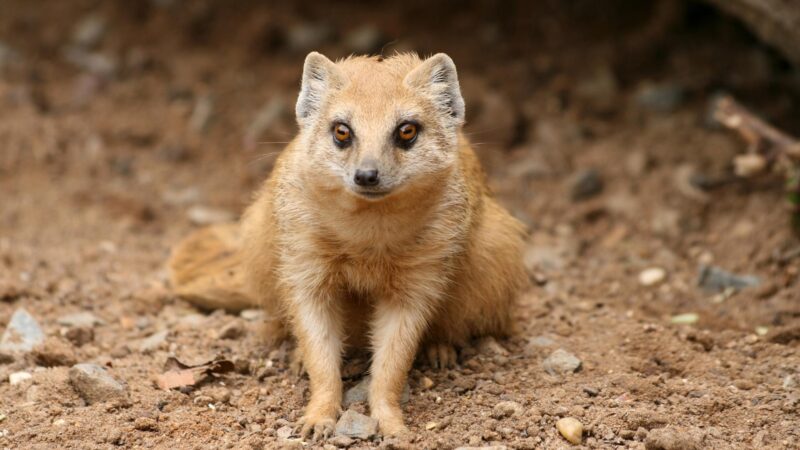
Mongooses are small furry creatures, usually 23 cm long and 1 kg to 6 kg in weight. They’re well-known for their fearless attacks on extremely venomous animals like king cobras.
They’re solitary animals and live in large groups known as mobs, packs, and colonies (depending on their species). They prefer to reside in burrows and feed on various animals such as birds, eggs, and sometimes, even fruits!
They use their agility and strength to toss the head of their snake prey and crack their skull with a powerful bite.
- Appearance: Mongooses have short legs, small ears, pointed noses, and long downy hair. In addition, the color of their fur varies from gray to brown and is usually drizzled with a light gray color.
- Size: 24 cm to 28 cm in length, 320 g to 5 kg in weight
- Color: Brown or gray
- Lifespan: 6 to 10 years
- Habitat: Woodlands, forests, and semi-arid locations
- Characteristics: These creatures are active and energetic with small ears, pointed noses, and furry tails.
Owl
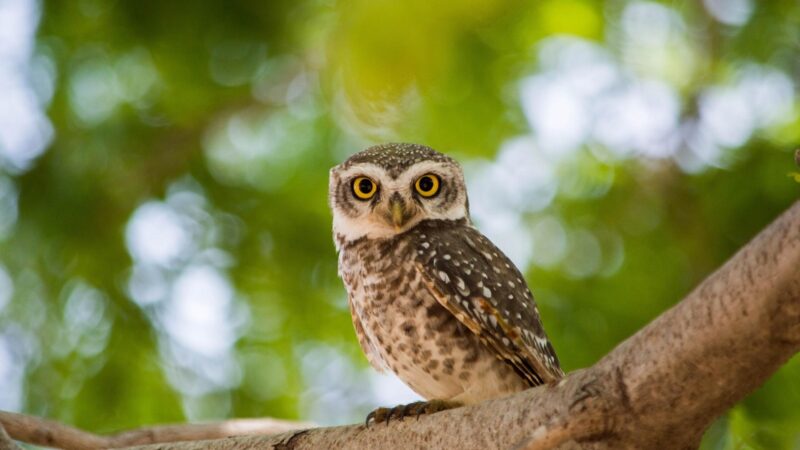
Owls are specialized predators. They have specialized eyes and ears that help them locate their prey quickly.
Additionally, they have sharp hooked beaks with acute vision and hearing that help them locate their prey by reflecting the sound through their ears. They also have unique feathers that allow them to fly without any noise.
Due to their sharp eyesight and agility, they hunt elusive and venomous snakes effectively. They attack by swooping down, striking, and using their strong claws to grab the snakes in the ground and taking off to a branch of a tree to eat them.
- Appearance: Owls have flat faces, large eyes, and small, hooked snoots. Their tails are short, and they have rounded wings with sharp claws and big feet.
- Size: 13 cm to 70 cm long, 3 to 4 pounds
- Color: White with shades of gray, tan, brown to deep brown
- Lifespan: 25 years
- Habitat: Mountains, plains, deserts, coniferous forests
- Characteristics: Owls are usually active during dusk and dawn and can be found either in groups or alone. Their ears and eyes are also particularly unique as it helps them find their prey’s location.
Red-tailed Hawk
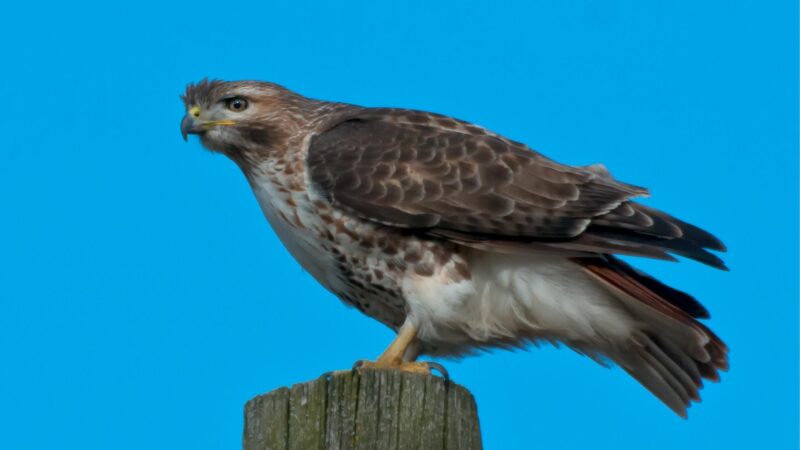
Red-tailed hawks are one of the biggest Buteo hawks found in North America. Males are slightly smaller than females—which is only normal among raptors.
These birds are built to soar high with their excellent wingspans, averaging over four feet. They’re also well-known to hunt and kill snakes using their strong claws to catch, suppress, and eat their snake prey.
- Appearance: Red-tailed Hawks usually have rich brown color on their upper body and pale color beneath. They have banded bellies with dark streaks on the undersides of their wings and between their shoulder.
- Size: 45 cm to 65 cm in length, and 1.1 kg in weight
- Color: Deep-brown upper body and pale undersides
- Lifespan: 10 to 15 years
- Habitat: Prairie groves, plains, woodlands, mountains, and roadsides
- Characteristics: These snake predators are very territorial and will stay in the same territory for years. Males usually patrol by flying around within their area to look for intruders, while females remain in their nest and guard there.
Snake Eagles

As their name suggests, snake eagles are large bird species that primarily prey on snakes. They have keen eyes and usually fly high to look for snakes on the ground.
They attack snakes by swooping suddenly on the ground and grabbing them using their sharp talon.
- Appearance: Snake eagles have black feathers with prominent large greyish to white patches on their wings. Meanwhile, their and tail are chestnut in color. The bottoms of their bodies are white, and their wings display black and white feathers, which are seen only during flight.
- Size: 59 cm to 70 cm long and 1.2 kg to 2.3 kg in weight
- Color: Brown bodies with black crown and gray to brown throats and cheeks
- Lifespan: 7 to 10 years
- Habitat: Wooded savannah and open woods
- Characteristics: Snake eagles are solitary birds with relatively large heads, sturdy bodies, and golden-yellow eyes. Their plumage ranges from pale brown to darker color on the upper parts, while the bottoms are much paler and banded.
Snapping Turtles
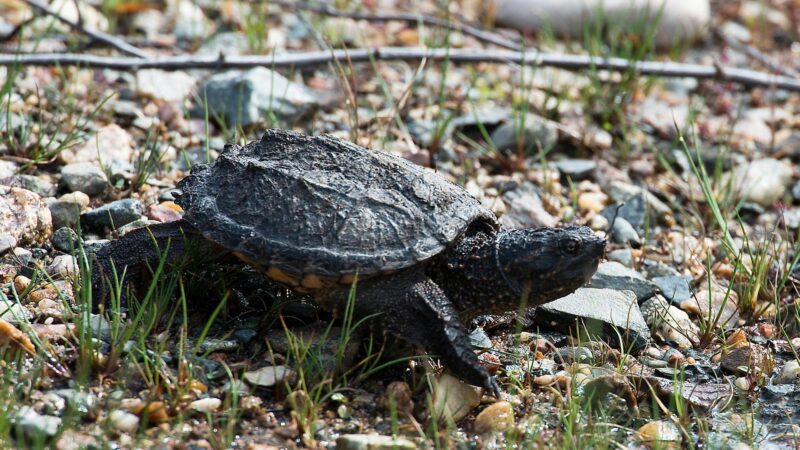
Snapping turtles are large and aggressive species with bony plates and long tails. They have a long neck, large head, and sharp and angular upper jaw.
They also own hard beaks with irregular cutting edges used for ripping their food. Furthermore, they are noted for their enormous size and feisty nature.
As omnivores, they have a diverse diet, such as:
- Birds
- Crayfish
- Carrion
- Insects
- Fish
- Frogs
- Small turtles
- Snakes
- Spiders
- Small mammals
- Plants
- Worms
Various plants are also part of their diet, like duckweed, java moss, hornwort, water hyacinth, and water lettuce.
Rather than attacking abruptly, they prefer to slip through and use their strong jaws to eat them. They use their sense of vision and smell to detect their prey and swiftly ambush them when they get the opportunity.
- Appearance: Snapping turtles usually have rough lumps on their heads, a dark, smooth top shell, and a small bottom shell. They have strong jaws and hard heads used for snapping their predators when they feel threatened.
- Size: 20 cm to 36 cm long (adult) and 4.5 kg to 16 kg (adult)
- Color: Tan, dark brown to black
- Lifespan: 30 years
- Habitat: Lakes, rivers, and streams
- Characteristics: The carapace or their top shells differ in color— from green and brown to black and are occasionally wrapped with moss. Their heads are large, with a long neck and a sharp, hook-shaped upper jaw.
Tiger
The tigers are the biggest, breathing cat species, recognizable for their orange fur, dark vertical stripes on their bodies, and white underside.
They’re known to feast on medium to large snakes when they are available. Before attacking their prey, they conceal themselves first before ambushing them.
- Appearance: Tigers have orange fur with dark, vertical stripes and white undersides. Nonetheless, their marking varies between their subspecies. For instance, the fur of the Siberian tiger is pale orange with only a few stripes, while the Sumatran tigers have dark striped fur.
- Size: 2.5 meters to 3.9 meters long for male adults and 2 meters to 2.8 meters for adult females in length. Their weight ranges from 90 kg to 310 kg for male adults and 65 kg to 180 kg for female adults.
- Color: Orange with some black stripes, the golden tiger with cinnamon-colored stripes
- Lifespan: 8 to 10 years
- Habitat: Grasslands, rain forests, mangrove swamps, and savannas
- Characteristics: Tigers are bold and active animals that love to take on challenges. They’re short-tempered and aggressive when it comes to hunting their prey.
Summary
Snakes have a lot of predators, including those that are listed in this guide. Like them, their predators are extremely fierce and will stop at nothing until they get their snake meal.
List of Sources
Bobcat. Smithsonian’s National Zoo & Conservation Biology Institute.
American Crocodile: Species Profile. (2021). National Park Service – U.S. Department of the Interior.
Learn about foxes. Commonwealth of Massachusetts.
Drabeck, D.H., Dean, A.M., Jansa, S.A. (2015). Why the honey badger don’t care: Convergent evolution of venom-targeted nicotinic acetylcholine receptors in mammals that survive venomous snake bites. National Library of Medicine.